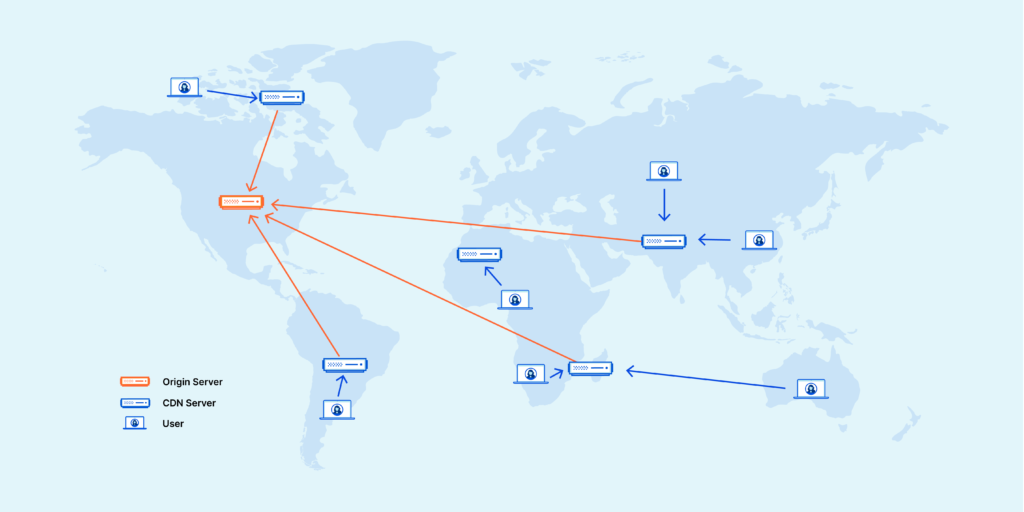Table of Contents
What is a CDN?
A CDN, or Content Delivery Network, is a distributed network of servers strategically placed in different geographic locations around the world. The main purpose of a CDN is to deliver internet content to end-users with high performance and availability.
A content delivery network (CDN) is a system of linked servers that reduces the time it takes for data-intensive web apps to load on a user’s browser. Delivery network or distribution network for content are both possible meanings of the acronym CDN. When a user accesses a website, information from the server must travel to their device through the global network. A large file, such as a video or website image, takes a long time to load if the user is located distant from that server. Instead, the website’s content is kept on CDN servers in closer proximity to the users, allowing for substantially quicker transfer times.
By speeding up the delivery of content and rich media to end users, CDNs aim to boost overall website performance. Today, content delivery networks (CDNs) service the vast majority of web traffic, including that of widely-visited sites like Facebook, Netflix, and Amazon.
History of CDN Technology
The concept of CDNs originated in the late 1990s when internet traffic started to grow rapidly. The first commercial CDN, Akamai Technologies, was launched in 1999. Since then, CDNs have played a crucial role in improving the delivery of online content.
CDN vs. Web Host
CDN is not the same as a web host. While a web host is responsible for storing and serving website files from a single server, a CDN caches website files across multiple servers located in different regions. This distribution of content allows CDNs to deliver content faster and more efficiently.
Learn more on What a Web Server is and How it Work?
Why is a CDN important?
A CDN is important for several reasons. Firstly, it helps reduce latency by serving content from servers that are closer to the end-users. This results in faster page load times and a better user experience. Secondly, CDNs help handle high-traffic loads by distributing the load across multiple servers. This prevents server overload and ensures smooth content delivery even during peak times.
1. Speeding Up Load Times
Website speed matters, perhaps more than ever before. Slow-loading pages can be a massive turn-off for your visitors, causing them to bounce off your site. CDNs are your trusty companions in this battle. By efficiently distributing content across multiple servers in various geographical locations, CDNs dramatically reduce page load times. This translates to a snappier, more responsive website, which, in turn, keeps visitors engaged and coming back for more.
2. Cost-Effective Bandwidth Management
Bandwidth costs can be a thorn in the side of website owners. Every time a user requests a page from your server, it consumes network bandwidth, and those costs can add up quickly. However, CDNs employ smart caching and other optimizations to significantly reduce the amount of data your origin server must provide. This not only streamlines the user experience but also cuts down on the expenses related to hosting.
3. Handling Traffic Surges
Imagine a situation where your website experiences a sudden influx of traffic due to a viral post or a marketing campaign. Without the proper infrastructure, this spike can lead to downtime or, even worse, a website crash. CDNs are equipped to handle such surges gracefully. They distribute the incoming traffic efficiently, reducing the load on your web servers and ensuring your site remains accessible even during peak times.
4. Reliability through Redundancy
In the world of websites, downtime is the enemy. Hardware failures or maintenance can cause disruptions, but CDNs come to the rescue once again. Even if one or more CDN servers go offline, others can seamlessly step in to fill the gap. This redundancy ensures that your website stays up and running, providing a consistent experience to your users.
5. Guarding Against DDoS Attacks
Cybersecurity is a top concern in the digital realm, and Distributed Denial-of-Service (DDoS) attacks pose a significant threat. These attacks flood your website with fake traffic, attempting to overwhelm and take it down. CDNs act as a formidable shield in the face of such onslaughts. By distributing the incoming traffic among several intermediary servers, they mitigate the impact on your origin server. This not only safeguards your website’s availability but also maintains its performance, even in the face of adversity.
What are the benefits of CDNs?
- Improved website performance and faster page load times
- Reduced bandwidth costs by offloading traffic to the CDN
- Enhanced security through DDoS protection and SSL encryption
- Global reach and scalability for businesses with an international audience
- Better SEO rankings due to improved website speed
What can a CDN deliver?
Static and dynamic data can both be delivered via a content delivery network (CDN).
Static content
Data on a website that does not vary from user to user is called “static content.” Every customer sees the same website header, logo, and fonts because the company rarely makes changes to them. Because of its inert nature, static data is well-suited for CDN hosting.
Dynamic content
Users of the same website will see different versions of the same piece of dynamic content including news feeds, weather forecasts, login status, and chat messages. The website needs to generate this data for each user and each interaction because it varies depending on factors including the user’s location, login time, and preferences.
A CDN can deliver various types of internet content, including:
- Static content such as images, CSS, and JavaScript files
- Dynamic content generated by web applications
- Streaming media such as videos and audio files
- Software downloads and updates
How does a CDN work?
A Content Delivery Network (CDN) is a complex system designed to enhance the performance and efficiency of content delivery over the Internet. A CDN works by caching content on edge servers located in different regions. When a user requests a webpage, the CDN automatically determines the closest server and delivers the cached content from that server. This reduces the distance between the user and the server, resulting in faster content delivery.

Here’s a simplified explanation of how a CDN works:
- Content Replication: CDNs consist of a network of servers strategically placed in various locations worldwide. These servers are often referred to as “edge servers” or “PoPs” (Points of Presence). When you use a CDN, your website’s static content (like images, CSS, JavaScript files, and videos) is replicated and stored on these edge servers.
- Proximity to Users: CDNs are strategically located close to areas with high internet traffic. By having multiple edge servers in different regions, CDNs reduce the physical distance between the user and the server. This proximity ensures faster content delivery.
- Request Routing: When a user requests content from your website, the CDN steps in. Instead of the request going directly to your web hosting server, it’s routed to the nearest edge server. This server checks if it has the requested content in its cache. If it does, the content is served directly from the edge server. If not, the edge server fetches the content from your origin server.
- Caching: Caching is a key feature of CDNs. The edge servers store cached copies of frequently accessed content. This means that subsequent requests for the same content can be served much faster because it’s already on the edge server. Caching strategies can be customized to ensure that the most relevant and frequently accessed content is stored.
- Security: CDNs also offer security features. They can protect against Distributed Denial of Service (DDoS) attacks by filtering out malicious traffic before it reaches your origin server.
- Content Optimization: Some CDNs offer content optimization features like image compression and script minification. These optimizations reduce the size of files, making them quicker to download.
- Analytics: CDNs often provide website owners with analytics and reports. This data can include information about website performance, visitor demographics, and more, helping website administrators make informed decisions.
CDN works by distributing your website’s content to a network of geographically dispersed servers. This not only reduces the physical distance between users and your content but also takes the load off your origin server, resulting in faster load times, cost savings, and enhanced security. It’s a powerful tool for delivering a high-quality user experience on the web.
How does CDN caching work?
CDN caching involves storing copies of content on edge servers for faster retrieval. When a user requests a file, the CDN checks if it has a cached copy. If it does, the CDN delivers the cached copy. If not, the CDN retrieves the file from the origin server, caches it, and delivers it to the user. Caching strategies can be customized based on factors like file type, expiration time, and user behavior.
What is a CDN used for?
CDNs are used for a variety of purposes, including:
- Website Acceleration: Speeding up website loading times.
- Content Streaming: Ensuring smooth video and audio streaming.
- E-commerce: Optimizing online shopping experiences.
- Security: Protecting websites from cyberattacks.
- Global Expansion: Serving content to an international audience.
CDN vs. Traditional Hosting
CDNs and traditional hosting have distinct purposes. Traditional hosting is suitable for small websites, while CDNs are essential for large websites or those with a global audience. Combining the two can offer the best of both worlds, ensuring fast loading times and reliability.
Content Delivery Networks have revolutionized the way we experience the internet. They have not only improved website speed and security but have also enabled global accessibility. As the internet continues to grow, CDNs will remain a critical tool in providing efficient content delivery.



